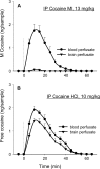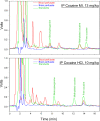Cocaine serves as a peripheral interoceptive conditioned stimulus for central glutamate and dopamine release
- PMID: 18682722
- PMCID: PMC2475658
- DOI: 10.1371/journal.pone.0002846
Cocaine serves as a peripheral interoceptive conditioned stimulus for central glutamate and dopamine release
Abstract
Intravenous injections of cocaine HCl are habit-forming because, among their many actions, they elevate extracellular dopamine levels in the terminal fields of the mesocorticolimbic dopamine system. This action, thought to be very important for cocaine's strong addiction liability, is believed to have very short latency and is assumed to reflect rapid brain entry and pharmacokinetics of the drug. However, while intravenous cocaine HCl has almost immediate effects on behavior and extracellular dopamine levels, recent evidence suggests that its central pharmacological effects are not evident until 10 or more seconds after IV injection. Thus the immediate effects of a given intravenous cocaine injection on extracellular dopamine concentration and behavior appear to occur before there is sufficient time for cocaine to act centrally as a dopamine uptake inhibitor. To explore the contribution of peripheral effects of cocaine to the early activation of the dopamine system, we used brain microdialysis to measure the effects of cocaine methiodide (MI)--a cocaine analogue that does not cross the blood brain barrier--on glutamate (excitatory) input to the dopamine cells. IP injections of cocaine MI were ineffective in cocaine-naïve animals but stimulated ventral tegmental glutamate release in rats previously trained to lever-press for cocaine HCl. This peripherally triggered glutamate input was sufficient to reinstate cocaine-seeking in previously trained animals that had undergone extinction of the habit. These findings offer an explanation for short-latency behavioral responses and immediate dopamine elevations seen following cocaine injections in cocaine-experienced but not cocaine-naïve animals.
Conflict of interest statement
Figures




References
-
- Ritz MC, Cone EJ, Kuhar MJ. Cocaine inhibition of ligand binding at dopamine, norepinephrine and serotonin transporters: a structure-activity study. Life Sci. 1990;46:635–645. - PubMed
-
- Reith MEA, Kim SS, Lajtha A. Structural requirements for cocaine congeners to interact with [3H]batrachotoxinin A 20-α-benzoate binding sites on sodium channels in mouse brain synaptosomes. J Biol Chem. 1986;261:7300–7305. - PubMed
-
- Premkumar LS. Block of a Ca(2+)-activated potassium channel by cocaine. J Membr Biol. 2005;204:129–136. - PubMed
-
- Zhang XF, Cooper DC, White FJ. Repeated cocaine treatment decreases whole-cell calcium current in rat nucleus accumbens neurons. J Pharmacol Exp Ther. 2002;301:1119–1125. - PubMed
Publication types
MeSH terms
Substances
Grants and funding
LinkOut - more resources
Full Text Sources

